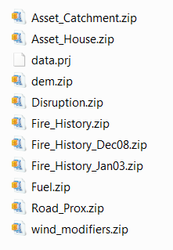Overview
When running a simulation Phoenix obtains input data from 3 sources.
- Data entered into the application directly, and saved in the project file,
- Files in the Gridded_Weather directory, and
- Files in the Data directory.
This document describes the data files that are obtained from the Gridded_Weather and Data directories.
The Gridded Weather directory is expected to contain NetCDF files obtained from the BOM.
The Data directory contains a variety of possible input layers that must be created by hand.
Gridded Weather
TBD - populate this section with a description of how to use the weather downloader
Refer to the manual for how to use weather entered directly into the UI/project file
Data layers
General Requirements
- All data layers must be in the same coordinate system, and this must be a map grid projection (grid reference in metres) not a geographic one (latitude and longitude in degrees).
In Victoria, we suggest using "VicGrid 94" which is a Lambert Conformal Conic Projection with a GDA 94 reference Datum.
Across Australia, we suggest "Geoscience Australia Lambert 94" projection which is a Lambert Conformal Conic Projection with a GDA 94 reference Datum. - The only data layer that MUST be provided is the Fuel Layer.
However, other layers make the simulation much more realistic. - As all data layers must be in the same coordinate system only one projection file is required.
The default name of this file is: "Data.prj" and is best located in the root "Data" directory.
The format of the projection file conforms to the requirements of ESRI ArcGIS 9.
Possible input layers
Phoenix will detect, and use, the following input layers if they are found in the Data directory:
- Fuel Layer
- Digital Elevation Model
- Disruption Layer
- Fire History Layer
- Wind Modifiers Layer
- Assets Layer
TBD - pull more out of both PHOENIX_data_preparation_20080413.pdf and Phoenix User Manual
Input data to the model must be prepared in a GIS such as ESRI's ArcGIS or MapInfo. This base data
is then converted into a format read by PHOENIX which is an ASCII grid broken into data "tiles", 30 x
30 cells wide. This tiling can be easily done in ArcGIS using a specially developed "Toolbox". The
base input data is usually at 20 or 30 m resolution, but when it is read into PHOENIX it is averaged
into larger cells to speed computations. Typically the grid cell size for PHOENIX computation is 100
or 200m, but could range from 50 to 500m depending on the nature of the terrain and the level of
detail required.
Files needed to run
Data directory
An example of the type of files in
the "Data" sub-folder. Notice they
are "zip" files. This makes copying
from one drive to another faster
and easier. The "data.prj" file
defines the geographic projection of
all the data files (input and output)
The only data layer that must exist to run PHOENIX is the "Fuel" data layer, however all the other layers make the
simulation more realistic. If there is no data file location specified, then the input value will be zero.
Gridded Weather directory
The "Gridded_Weather" folder holds the gridded forecast weather produced twice a day
by the Bureau of Meteorology. A downloading process has to be put in place to get this data, but it
is restricted to registered users. PHOENIX will also run on a single stream of weather data .
Info about the weather downloader required.
